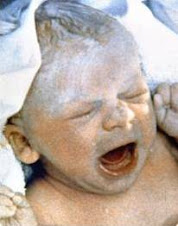For three years, Saralda Ortiz-Howard and her
husband tried to get pregnant until they decided to turn to fertility
treatments. They spent more than $30,000 on multiple cycles of both
intrauterine insemination (IUI) and in vitro fertilization (IVF) but neither was successful, not
to mention that the physical side effects of the treatments were harsh.
“The amount of medicines that I was taking, my body
felt out of whack,” Ortiz-Howard, now 43, said. “I felt that was one of the
reasons I wasn’t successful in achieving pregnancy.”
Then the Hicksville, New York woman learned about
mini-IVF, an alternative to traditional IVF that has been in use for years but
isn’t as widely known or administered. Her physician, Dr. Zahir Merhi, director
of research and development in IVF technologies at New Hope Fertility Center in
New York City, explained that since mini-IVF uses a smaller amount of
medication it would be less taxing on her body.
In June, Ortiz-Howard started mini-IVF treatments
and said immediately she noticed her body wasn’t as swollen and she didn’t have
the severe night sweats that she had experienced with IVF.
“With the low dose, I felt regular, I felt normal,”
she said. “Everything felt so much better.”
What is mini-IVF?
Mini-IVF or “minimal stimulation IVF,” is also referred
to as “mild stimulation IVF” or “gentle stimulation IVF.”
“It’s very similar to IVF but you’re not
stimulating the ovaries too much with high doses of medication,” Merhi said.
There isn’t data available on the number of U.S.
clinics that offer mini-IVF, in 2014, there were 143 Society for Assistive
Reproductive Technology (SART)-member clinics that submitted data about their
use of the treatment.
Proponents of mini-IVF say it’s an option for some
women who may respond better to lower doses of medication and the quality of
the eggs and the embryos might even be better.
“There is this feeling that high doses of shots can
be detrimental to the quality of eggs,” Merhi said.
Unlike traditional IVF which requires daily
injections, mini-IVF needs fewer injections and uses tablets as well as a nasal
spray in place of the “trigger shot” used for traditional IVF. However, the
specific protocol varies between patients.
Since less medication is used, mini-IVF can be more
affordable than IVF. A traditional IVF cycle can cost anywhere between $12,000
and $15,000 while a mini-IVF cycle might be as low as $4,500, on average.
Mini-IVF has drawbacks
Critics say that mini-IVF is not the magic bullet
proponents claim it is. For starters, IVF is the most successful fertility
treatment because the medications are meant to yield a large amount of eggs,
said Dr. Peter Ahlering, medical director of the Missouri Center for
Reproductive Medicine in St. Louis.
Studies show that after female age, the greatest
predictor of pregnancy and live birth from IVF is the number of embryos
produced.
“In general in IVF, quality and quantity run in
parallel,” said Dr. Norbert Gleicher, founder and medical director of the
Center for Human Reproduction in New York City.
Mini-IVF, on the other hand, can take more cycles
on average to result in a pregnancy and a baby.
“The problem with the process is that if you get
fewer eggs, then the probability of success is lower,” Ahlering said.
For women under age 35, 23.1 percent of mini-IVF
cycles resulted in a single live birth, compared to 6.2 percent for women
between ages 38 and 40, according to SART statistics. With traditional IVF,
women under 35 had a 31.9 percent success rate, compared to 18.3 percent for
women in the older demographic.
A study conducted by New Hope Fertility Center and
published in the American Journal of Obstetrics and Gynecology found the live
birth rate for mini-IVF was 49 percent versus 63 percent for conventional IVF.
Experts say the idea that mini-IVF results in
better-quality eggs and embryos while high-dose stimulation can result in
poorer quality eggs and embryos is a myth.
“If that were true, everybody would be doing
[mini-IVF] all the time for all patients,” Ahlering said.
Another thing women should know is that similar to
traditional IVF, there is always the chance that they will not respond to the
medication, or get quality eggs or embryos, Merhi said.
Although mini-IVF is often cited as a means to
prevent ovarian hyperstimulation syndrome, a condition that can cause bloating,
pain, weight gain or more serious symptoms, Ahlering said that there are
traditional IVF medication protocols that can prevent this from happening.
“You can still achieve the high clinical pregnancy
rates and get a good number of follicles but don’t expose the patient to extra
risk of hyperstimulation,” she said.
Mini-IVF may be an option for some women, such as
those who have diminished ovarian reserve, because regardless of the amount of
medication they take, the same number of eggs will likely be retrieved,
Ahlering said.
“I’m always going to recommend [the method] which
gives the patient the optimal probability of pregnancy,” he said.
Although mini-IVF cycles are cheaper, if multiple
cycles are required, it may not be cost saving in the long run.
“The whole thing is completely bogus [and] it’s a
disservice to patients. It’s amazing that people are still using it,” Gleicher
said.
For Ortiz-Howard, however, mini-IVF may
turn out to be her best option for having a healthy baby. Unlike previous IVF
cycles that yielded five or six viable, quality embryos, this time around
doctors implanted four and froze seven. Now four weeks pregnant, she and her
doctors are hopeful about the future.
“So far everything is great,” she
said.











